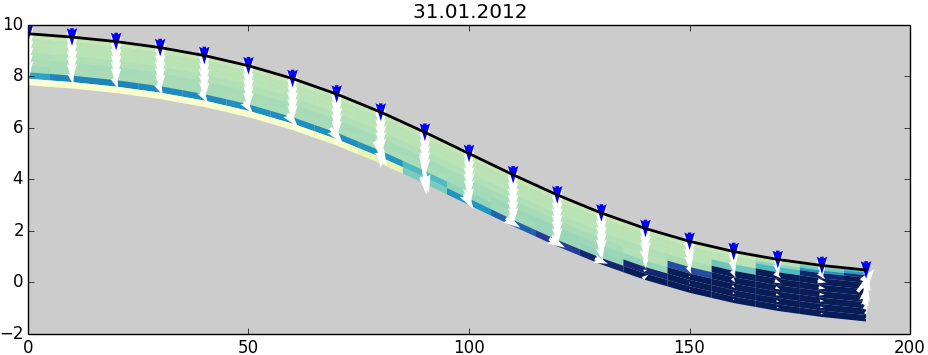|
2.0.0b10
catchment modelling framework
|
|
2.0.0b10
catchment modelling framework
|
In this chapter we will bring our 1D cell from [[wiki:CmfTut1d]|and the lateral connections from CmfTutDarcianLateralFlow and CmfTutSurfaceRunoff together to a complete hillslope model. As in these tutorials will not include rainfall and ET to keep the code better readable. With the information from CmfTutTestData, CmfTutMeteostation and [wiki:CmfTutET]] it should be possible to extend this tutorial on your own to a complete model.
Here we will define the catena of cells on the hillslope. For "real" applications, you will load the topography of the hill slope from a file
z(x). The cmf project will be p again.Our hill slope should have an exponential slope, is 200 m long and is discretized into 20 cells. By using different cell areas, a quasi-3D effect for converging or diverging fluxes could be applied, but in our example the area of each cell is fixed to 10m x 10m.
The topological connection of the cells is simple, we only need to connect each cell with its lower neighbor. The width of the connection is 10m.
Now, each cell needs to have soil layers, exactly the same way as in the setup code in [wiki:CmfTut1d], just with some other layer depth and the "default" Van Genuchten-Mualem retention curve - it is better to parameterize your soil type of course (Hydraulic head (subsurface)).
Using Darcy and KinematicSurfaceRunoff as lateral connections as in CmfTutDarcianLateralFlow and CmfTutSurfaceRunoff. Due to the defined topology, we can use the cmf.connect_cells_with_flux function.
For our example we will use the following boundary conditions:
1. No flow to the deep groundwater (impervious bedrock) 2. No flow at the upper side of the hillslope (upper side is water shed) 3. Steady rainfall of 10mm/day to each cell 4. Constant head boundary at the low end of the hillslope at 0.47m below the lowest cell in 10 m distance.
Boundary conditions 1 & 2 are implemented by doing nothing (no connection is no flow). Boundary condition 3 is applied as follows:
Boundary condition 4 (outlet) is applied by using a DirichletBoundary, using the NewOutlet method of the project. The outlet is connected with the Darcy connection to each soil layer. The surface water of the lowest cell p\[\[-1\]|is connected to the outlet with KinematicSurfaceRunoff
The last thing needed for the complete setup code is the solver. With Richards and Darcy equation, we have again a stiff system and thus use the CVODE solver:
In the runtime code, you need to define which data should be collected during runtime and handle the data accordingly. In [wiki:CmfTut1d] we have used two different approaches - save data to a file during runtime and collect the data in a list for later visualization. You can of course apply both techniques here also. However, if you want to observe the state changes in a 2D hillslope and not only the runoff, an image with time on the one axis and depth on the other is not sufficient. Hence we are going to present the results live during the model run in an animation.
First we need a kind of drawing, that shows all states. As always in cmf, you can design the output as you like. One possibility, drawing everey layer as a sheared rectangle colored by a state variable and arrows indicating the flux between the layers is already bundled with cmf in the cmf.draw module - the hill_plot class. This class is not very well documented, but you can have a look to the source code.
This creates a hill_plot of our hillslope:
Animations can be created using the FuncAnimation class from the matplotlib.animation module. The drawing (and in our case advancing of the model) is done in a function taking the frame number as the first argument:
Last part is to create the animation object and show what we have done. The animation starts directly.
The result after 30 days of simulation looks like this:

1. Stop the rain after 100days. (a few minutes) 2. Save the outlet water balance in a list and plot it after calculation (a few minutes) 3. Use real weather data (some more work) 4. Use ET, snowmelt etc. (a few minutes) 5. Go in the field, measure pF curves, collect meteo data and discharge and make a real model. Learn from model failure (time...)